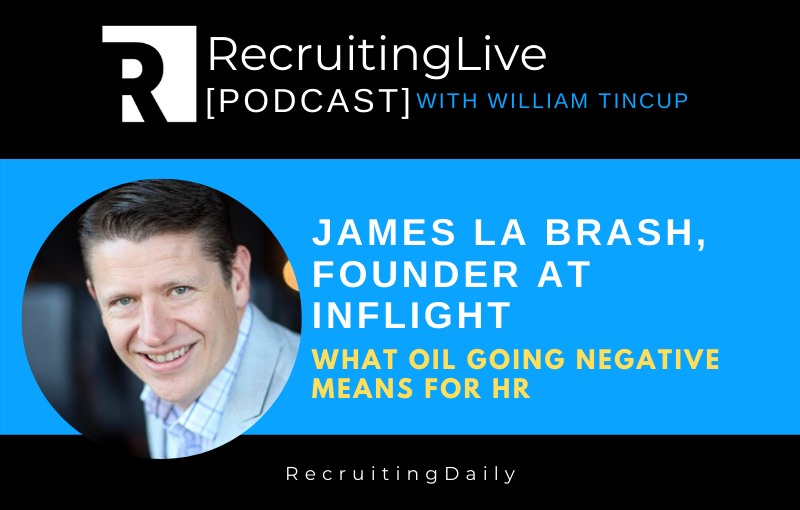InFlight – What Oil Going Negative Means for HR with James La Brash" cover_image_url="https://recruitingdaily.com/wp-content/uploads/2021/08/inflight-oil-going-negative-james-la-brash.png" bgcolor="#f5f5f5" txtcolor="#1a1c1d" accent_color="#1899ff" font_family="Roboto"]
InFlight – What Oil Going Negative Means for HR with James La Brash
Happy Wednesday everyone. Today we are talking about a fantastic topic.
This is going to be really cool. Not necessarily directly related to COVID, but the topic today is “What does oil going negative mean for HR?”
Our guest today is James La Brash. He is the founder and one of the two managing directors over at InFlight.
 What does InFlight do?
What does InFlight do?
InFlight is in the business of making your existing software better and more efficient. We add an invisible layer on top of one or more enterprise applications, with the intention of smoothing out rough edges and making them easier to use in the name of efficiency. It’s a hard thing to explain because it’s not really like anything else on the market.
If you have 10,000 people filling out timesheets weekly, why not pull those into MS Teams or Slack, into applications they are already using? If you have a candidate experience turning off candidates, sometimes a few simple improvements can make a dramatic difference and give you instant ROI.
This can be applied to any part of the sourcing, hiring, or core HR process. “Pre-hire to retire.”
There’s no one that could have predicted what we’re all going through. What are you seeing now in society and HR? What’s your vantage point?
I’m seeing the same as a lot of others. Primarily, managing the best we can on the homefront and very keen to get out of lockdown, back into the office and in public. A strange phenomenon is starting to happen, where it takes 3 weeks for humans to form habits. So we’ve been in lockdown now for more than 3 weeks. What’s the return to the office going to feel like? It’s going to feel foreign.
One of the things I want to ask about the HR tech landscape. So, we go to recovery and come out on the other side. Do you see the same approach to these technologies or will it be different in a post-recovery world?
The approach is going to be different. There are still a ton of question marks.
I’m not an economist so take all this with a (or many) grains of salt. Manufacturing and distribution have become very interdependent. If you imagine the world as a series of interconnected conveyor belts. What has happened is something called a “manufacturing rate surge.” You basically get conveyor belts out of sync. When that happens, if you don’t have buffering in between them to manage that, you get into some sticky situations.
One of the very premises of LEAN manufacturing is Just In Time Inventory. People have worked very hard to remove unnecessary buffers in the process. That will probably change. With budgets frozen for some or all of 2020, what might be an economic downturn of unknown proportions, there will be many more eyes on every dollar spent. If something can’t demonstrate a fairly instant or certain return, I’m not sure that there will be a lot of free capital to make the kind of investments you saw pre-COVID.
We have to do a different podcast on LEAN and the failures of LEAN at some point. One kink in that chain throws everything off in a major way.
It’s a very low probability, high impact scenario. Even if you have double or triple redundancy in your supply chain, if all of that goes south, then everything’s held up. Or you end up in situations like the price of oil’s May contract going negative because there’s not enough storage space in Oklahoma. It’s just bananas.
I want to get to that. But one of the things I wanted to ask you before that is this. What assets do you see that are underleveraged or underutilized in terms of data analytics or tools?
Real data around the end to end candidate flow. Within a candidate’s journey, very few are tracking the journey using a consistent set of tools that look at where along the journey candidates are falling off. Take a job that’s been federated from the ATS into Linkedin and Glassdoor, and the candidate finds the job on Google. They are forwarded along a chain back to the actual application, filling out the application over and over before they hit the actual ATS. Keep in mind that if you’re putting up that many hurdles, the best candidates are not going to hang out long enough to jump through that many hurdles. In economies with any unemployment rate. The inability to connect the points of the candidate journey and watch for those hurdles in order to eliminate them.
Tune in for more on this topic!
The discussion continues in the podcast link above, including the correlation between talent supply and oil. What does an oversupply mean for HR, and what can be done?
We also discuss James’ vision for recovery and what recruiting will look like on the other side of this. Tune in and let us know what you think.
The RecruitingDaily Podcast
Authors
William Tincup
William is the President & Editor-at-Large of RecruitingDaily. At the intersection of HR and technology, he’s a writer, speaker, advisor, consultant, investor, storyteller & teacher. He's been writing about HR and Recruiting related issues for longer than he cares to disclose. William serves on the Board of Advisors / Board of Directors for 20+ HR technology startups. William is a graduate of the University of Alabama at Birmingham with a BA in Art History. He also earned an MA in American Indian Studies from the University of Arizona and an MBA from Case Western Reserve University.



Discussion
Please log in to post comments.
Login